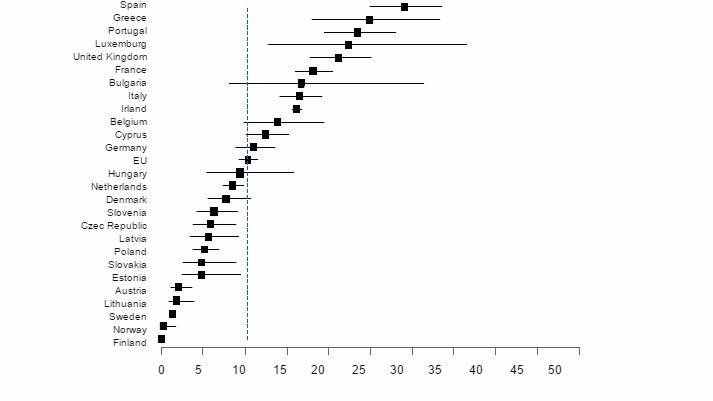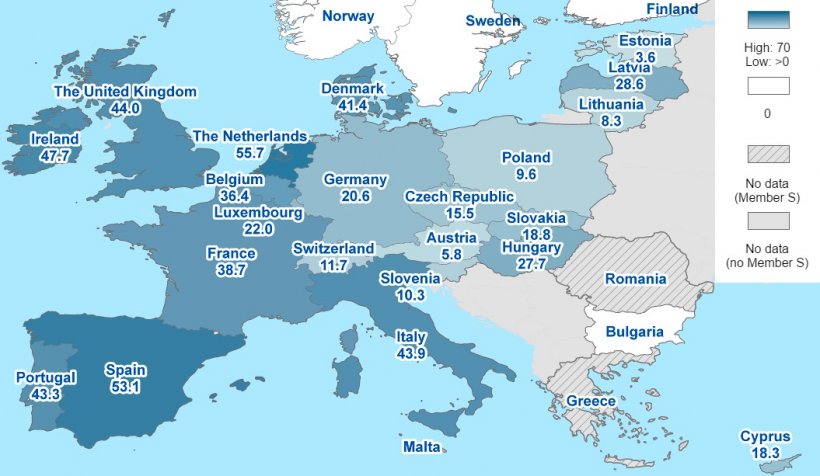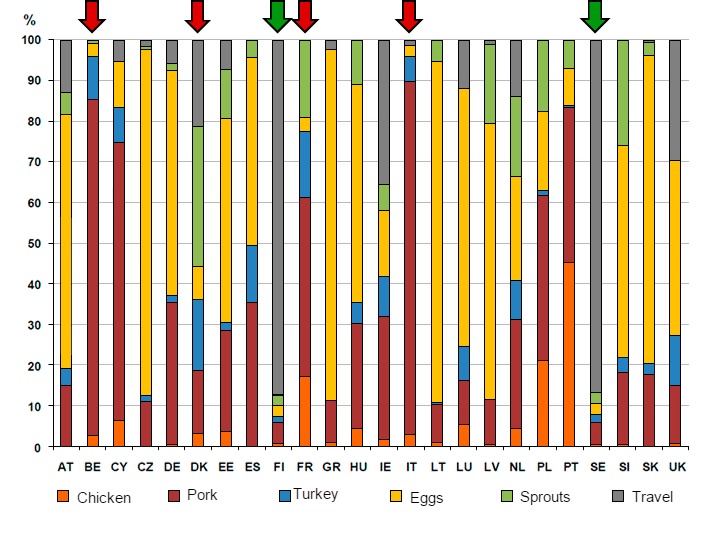The context of Salmonella control; Momentum in the first decade of the 21st century
During the first decade of the 21st century, Salmonella became one of the main pathogens to be controlled in pigs. The high number of human cases of salmonellosis, exceededing 200,000 per year at that time in the European Union (EU), and the success, at least in part, of control programs in northern countries led to a series of baseline prevalence studies in poultry and pigs in the EU, the results of which would serve to establish the objectives of future programs for control and reduction of prevalence in each of the Member States. Cross-sectional studies in breeding and fattening pigs revealed more or less important prevalences in countries with high production and a strong export industry (EFSA, 2008, 2009) (Figure 1A and 1B). However, the control plans, which should have begun in 2012, have still not been implemented in most European countries today.


Figure 1. Salmonella prevalence in fattening pigs in UE countries (EFSA, 2008)

Figure 2. Salmonella prevalence in breeding sows in UE countries (EFSA 2010). Data shows percentage of positive farms
Table 1. Status of Salmonella control programs in EU countries
| Country | References | Starting Date | Type of programm | Characteristics | Strategies |
| Sweden Norway Finland | Bengtsson et al., 2009 Hofshagen et al., 2007 Huttunen et al. 2006 |
Since the 60s | Eradication | Bacteriological analysis of samples from feed mills, farms and meat. | If positive results are found a combination of stamping out of groups of animals and implementation of hygienic measures controlled by repeated sampling is usually practiced. |
| Denmark | Baggesen et al. 1996 Alban et al., 2012 |
1995 | Mandatory control programme Reviewed and updated in 2010-2012 |
First implemented control programme at the UE Farms are categorized based on serology results Reduction objectives based on carcass prevalence at slaughter . |
Farm control measures with an emphasis in biosecurity and slaughterhouse hygiene. |
| Ireland | Quirke et al. 2001 | 1997 | Mandatory control programme Reviewed and updated in 2010 |
Farms are categorized based on serology results After the 2010 review, there are two categories (<50% and >50%). Pending to be updated |
Recommendation to implement on farm control strategies for positive farms |
| Germany | Osterkon et al. 2001 | 2002 | Voluntary control programme. | Farms are categorized based on serology (similar to initial Danish system ) | Recommendation to implement on farm control strategies for positive farms . |
| England | Snary et al. 2010 | 2002 | Mandatory control programme | Initially, program farms were categorized based on serology <50%; >50%; >75% In 2008, all farm showing seroprevalence >10% were classified as positive. Nowadays, no serological control. |
All farms should have a Salmonella control plan. |
| The Netherlands | Hanssen et al. 2007 | 2005 | Mandatory control programme | Farm serology (similar to initial Danish programme) Random sampling of carcasses in all slaughterhouses |
Recommendation to implement control strategies in positive farms and hygiene measures at slaughterhouses with carcass prevalence above 0.8% |
Reasons for the failure to implement compulsatory control programs in the EU
Microbiological risk analysis based on data from prevalence studies on breeding and fattening pigs in the EU pigs revealed that control programs were not likely to be viable from a cost-benefit point of view, the benefit being the reduction in the number of human cases. (EFSA, 2010).
In addition, the economic crisis in the European countries led to a reduction of resources allocated to new disease control plans.
Also, the success of salmonella control programs in poultry has led to a reduction of more than half the number of human cases (currently around 80,000 cases per year).
Finally, the complexity of porcine production and the epidemiology of Salmonella infection make it difficult to establish specific and extrapolable control measures, as opposed to what happens in poultry control.
Why is Salmonella still important?
Although we might think that Salmonella is a pathogen "gone out of fashion", it still has great relevance for the swine industry:

• Salmonella is the main zoonosis in pigs.
• The relative % of cases related to Salmonella contaminated pork consumption has increased as a result of the success of Salmonella control programs in poultry. In countries where poultry meat is free of Salmonella, pork and eggs are the main sources of human salmonellosis (Figure 1C)

Figure 3. Estimation of salmonella source for humans (EFSA,2011). Red arrows indicate countries (Belgium, Denmark, France and Italy) where pork is the main source of Salmonella as consequence of successful poultry control programs
- Salmonella is one of the pathogens that has developed the most resistance to antibiotics and is presented as one of the microorganisms to be monitored in the recent opinion on antibiotic use reduction in animal production published by EFSA-EMA (EFSA, 2017).
- Although interest on Salmonella control has somehow faded at the level of public institutions, its presence in pork remains one of the limiting factors for exports, causing losses to the industry.
Control of Salmonella worldwide
Few changes have emerged in recent years regarding Salmonella control. The most striking one is probably the rapprochement of positions between the European approach —based initially on farm infection control— and the strategies of the United States, focused on avoiding meat contamination at the processing plant (Alban et al. 2012). The limited success of some farm control programs (Walia et al. 2016) and the evidence that some of the contamination occurs in the later stages (see other articles in the Salmonella section of 3tres3) are the two main reasons why many experts on Salmonella favour post-farm control or a combination of farm-level measures and improved hygiene in transport, lairage and slaughter
At the end of 2015, FAO published a report on available control measures to reduce the risk of pork contamination based on experts' opinion on Salmonella control in pigs (FAO, 2015). This report is being used for the development of the new Codex Alimentarius on "Prevention and control of Salmonella in pigs". It reviews potential control measures on farms, transport, slaughterhouses and processing of pork. Regarding the information on farm control and slaughter line, the concepts, recommendations and conclusions agree with the idea exposed in the previous paragraph; the trend in control should shift towards a combination of farm control measures, biosecurity strategies and additional measures such as addition of organic acids into the diet, vaccines or meal feeding, with improvements in post-farm control. So, basically, measures to avoid carcass contamination at the end of the slaughter line: Chilling, hot water showering, chemical and/or organic acid treatments, improvements in hygiene, flaming, scalding, etc.
Table 2. Summary of main conclusions on Salmonella control on pork chain (FAO, 2015).
| Production stage | Control measure | Effectiveness | Recommendation | |
| Farm | Biosecurity | |||
| External | Reduce Salmonella introduction on farm | Control of replacement animals, wild animals, feed, vehicles, etc. | ||
| Internal | Reduce Salmonella spread within the farm | Mixing of animals, working flow, footbaths, equipment hygiene, etc. | ||
| Vaccination | Useful against same serotype. Interferes serological control programs | Can be included as control measure but it will interfere with serology of control programs | ||
| Organic acids | Dependent on doses, duration and type of acid | Can be useful to reduce prevalence | ||
| Meal feed | Improves intestinal health | Can be useful to reduce prevalence | ||
| Transport and lairage | Improvement of hygiene protocol | Reducing Salmonella presence | Further studies are required | |
| Slaughterhouse | Scalding | Reduces Salmonella carcass concentration | HAPPC point | |
| Flaming | Reduces Salmonella carcass concentration | HAPPC point | ||
| Slaughter line hygiene | Can avoid cross contamination | |||
| Shower with Lactic acid , Cl-, peroxide, etc. | Variable effectiveness | Further studies are required | ||
| Chilling | Reduces Salmonella growth | Recommended use |




